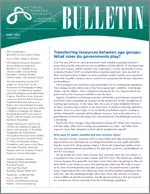
Additional titles in the NTA Bulletin series Over the past 100 years, most governments have steadily expanded social programs that provide cash and services to children and the elderly. These programs are funded by taxes paid largely by the working-age population. Thus changes in the relative size of the three age groups--children, working-age adults, and the elderly--have a significant impact on the size of government programs and on the resources available to pay for them. The National Transfer Accounts (NTA) project helps shed light on government opportunities and challenges by providing estimates and forecasts of taxes that will be paid and public benefits that will be received by all age groups given current tax and benefit policies. In this way, NTA estimates the size of the fiscal adjustment that countries will need to make in the future in response to changes in population age structure. In fact, the age profile of public benefits is likely to shift over time--for example, with increased investment in education for children and increased investment in healthcare for the elderly. Pension reforms may also shift some of the burden of population aging away from public programs toward family resources and the use of saving and investment income. NTA data can be combined with these alternative policy scenarios to produce medium- and long-term fiscal forecasts.
|
Additional titles in the NTA Bulletin series Over the past 100 years, most governments have steadily expanded social programs that provide cash and services to children and the elderly. These programs are funded by taxes paid largely by the working-age population. Thus changes in the relative size of the three age groups--children, working-age adults, and the elderly--have a significant impact on the size of government programs and on the resources available to pay for them. The National Transfer Accounts (NTA) project helps shed light on government opportunities and challenges by providing estimates and forecasts of taxes that will be paid and public benefits that will be received by all age groups given current tax and benefit policies. In this way, NTA estimates the size of the fiscal adjustment that countries will need to make in the future in response to changes in population age structure. In fact, the age profile of public benefits is likely to shift over time--for example, with increased investment in education for children and increased investment in healthcare for the elderly. Pension reforms may also shift some of the burden of population aging away from public programs toward family resources and the use of saving and investment income. NTA data can be combined with these alternative policy scenarios to produce medium- and long-term fiscal forecasts.
|





